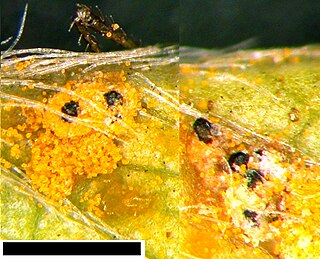
Stachybotrys is a genus of molds, hyphomycetes or asexually reproducing, filamentous fungi, now placed in the family Stachybotryaceae. The genus was erected by August Carl Joseph Corda in 1837. Historically, it was considered closely related to the genus Memnoniella, because the spores are produced in slimy heads rather than in dry chains. Recently, the synonymy of the two genera is generally accepted. Most Stachybotrys species inhabit materials rich in cellulose. The genus has a widespread distribution and contained about 50 species in 2008. There are 88 records of Stachybotrys on Species Fungorum, of which 33 species have DNA sequence data in GenBank. Species in the genus are commonly found in soil, plant litter and air and a few species have been found from damp paper, cotton, linen, cellulose-based building materials water-damaged indoor buildings, and air ducts from both aquatic and terrestrial habitats.

Pleosporaceae is a family of sac fungi. They are pathogenic to humans or saprobic on woody and dead herbaceous stems or leaves.

Bipolaris is a genus of fungi belonging to the family Pleosporaceae. It was circumscribed by mycologist Robert A. Shoemaker in 1959.

The Phaeosphaeriaceae are a family of fungi in the order Pleosporales. Species in the family have a cosmopolitan distribution, and are generally nectrotrophic or saprobic on a wide range of plants.
The Didymosphaeriaceae are a family of fungi in the order Pleosporales. The family was erected by Anders Munk in 1953.
Paraphaeosphaeria is a genus of fungi in the Didymosphaeriaceae family. The genus has 23 species found in Europe and North America. Anamorph forms are found in the genus Paraconiothyrium. The genus was circumscribed by O.E. Eriksson in 1967.
Montagnula is a genus of fungi in the family Didymosphaeriaceae. The genus, circumscribed by mycologist Augusto Napoleone Berlese in 1896, contains an estimated 24 species in 2008, but is probably polyphyletic as currently circumscribed. It was originally placed in family Montagnulaceae, before that family was dissolved and it was later placed in family Didymosphaeriaceae, with 34 species.
Salsuginea is a genus of fungi in the class Dothideomycetes. The relationship of this taxon to other taxa within the class was unknown in 2007. Until Kevin D. Hyde & Tibpromma, 2013 introduced family Salsugineaceae within the order of Pleosporales.
Keissleriella is a genus of fungi, that was originally placed in the Massarinaceae family, before being placed in the Lentitheciaceae family.

Apiospora is a genus of fungi which cause plant diseases. It gives its name to the family Apiosporaceae, which contains a number of other genera. This is historically a name for the teleomorph (sexual) life-cycle stage of the fungus; for some species the corresponding anamorph name is Arthrinium.

Pestalotiopsis is a genus of ascomycete fungi in the Sporocadaceae family.
Seimatosporium is a fungus genus within the family Sporocadaceae.
Clonostachys is a genus of fungi in the order Hypocreales and family Bionectriaceae.
Dothiora is a genus of fungi belonging to the family Dothioraceae.
Evan Benjamin Gareth Jones is a British mycologist. His main area of research interest is aquatic fungi, particularly marine fungi. He has supervised about 100 PhD and MSc students, published approximately 600 research articles and is a highly cited scientist. Other research interests include marine biofouling, biodeterioration of materials, and wood decay by fungi.
The Lentitheciaceae are a family of fungi in the order of Pleosporales. They are found world-wide with the greatest contributions found in Europe and Australia.

Neocamarosporium is a genus of ascomycete fungi, as accepted by Wijayawardene et al. 2020. The species are typically halotolerant, being commonly found in saline environments like in saline water, hypersaline soils and especially in association with halophytes.







